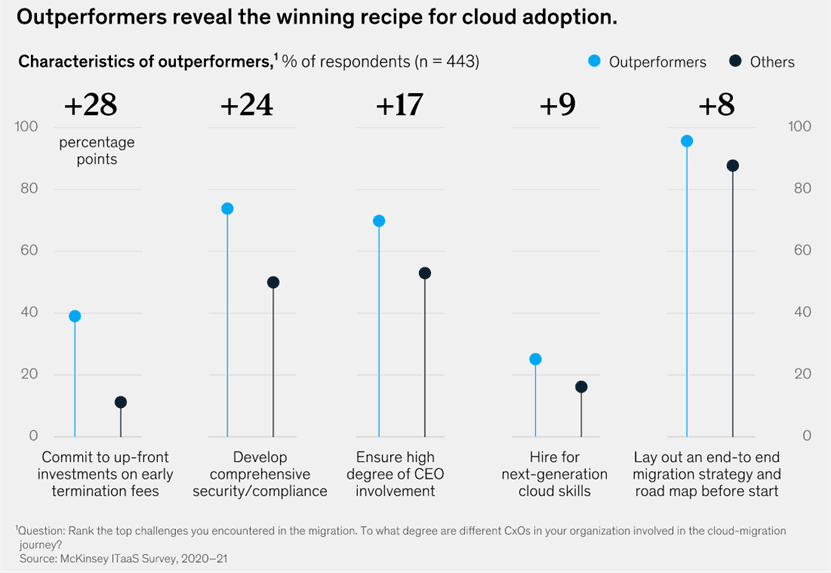Cloud migrations are considered one of the most daunting tasks in IT. It’s also one of the most essential. By 2025, Gartner estimates that over 95% of new digital workloads will be deployed on cloud-native platforms, up from 30% in 2021, while the global cloud market will grow to $1 trillion by 2028. No business wants to miss the boat on cloud technology, yet 90% of CIOs have experienced failed migration projects and only 25% said they completed a migration within their deadline. Another report found that 75% of cloud migrations ran over budget and 38% ran behind schedule, with just 15% of surveyed organisations pulling off a successful migration within their budget and timeline.
So, what’s the secret to a cloud migration success? Surprisingly, it has everything to do with the non-technical elements of a migration, such as securing leadership buy-in and implementing effective change management. In this insight, we explore why these non-technical elements are so critical and how you can holistically assess and plan a migration and get it right the first time.
READ MORE: Discover the critical factors for cloud migration success in our new report Cracking the Code to Cloud Migration Success: 5 Key Insights from Australian Organisations.
The secret to cloud migration success
A 2021 McKinsey report revealed the high performing companies that achieved cloud migration success were all about committing to up-front investments, prioritising security and compliance, gaining strong buy-in from the CEO, hiring the right cloud experts, and developing complete cloud migration roadmaps before the move.
These successful companies were 32% more likely to have involved CEO sponsors who were visibly active in developing and supporting the complete cloud migration strategy and implementation roadmap, including the security and compliance elements. It’s clear that cloud migrations are more likely to be successful when your CEO and Board has your back, providing clear support and communication about the cloud adoption strategy.
Another interesting discovery was that 57% of these companies are more likely to prioritise recruitment for advanced cloud skills, such as CloudDevOps and CloudFinOps (Read more about why you need a CloudFinOps role for effective cloud cost management).
RELATED CONTENT: Case study: Establishing an AWS cloud environment for a water provider

Case studies
These findings are bolstered by some high-profile cloud migrations where the organisations touted non-technical elements as playing a large role in their cloud migration success.
Social media platform Pinterest needed to move from its legacy cloud infrastructure to a next-generation cloud system. They completed the move in six months, transferring the outdated backend to the new cloud system, increasing reliability, innovation, and scalability. The key to their success was securing the support of the business and getting stakeholder buy-in.
The cloud engineering team first approached the stakeholders that would benefit most from the migration and provided them with the tools to help them transition smoothly to the new cloud system. They also appointed a consultant with each team to ease the move. As the early adopting stakeholders saw success, they naturally shared the good news and secured support from other key stakeholders, creating a snowball effect.
Spotify
Audio-streaming giant Spotify needed to move from its large and cumbersome in-house data centres to a cloud platform. They pulled off the move with minimal disruption and costs, and the migration increased scalability and gave Spotify’s engineers more freedom to innovate. They succeeded because they didn’t rush it, spending two years on pre-migration preparation, investigating different strategies, building use cases to present to the business, and ensuring complete readiness before making the move.
They also secured stakeholder buy-in and consulted their engineers and other stakeholders on the migration, building a team of advocates and supporters. Lastly, Spotify assigned a dedicated cloud migration team to undertake the project. This ensured the cloud migration was fully focused and completed quickly within deadlines.
Australian state transport authority
An Australian state transport authority needed to retire its data centres and move to the cloud to unlock cost efficiencies and meet environmental objectives set by its Board. Kinetic IT identified early on that it would be critical to prioritise both the technical and non-technical aspects of the migration. The team conducted careful planning to thoroughly understand the customer’s needs before the migration, actively collaborating with all stakeholders from suppliers to executives.
After identifying the customer’s objectives, Kinetic IT adopted a risk-averse strategy in alignment with the budget and time challenges presented in the business case. The team also developed a comprehensive migration roadmap to ensure the migration of the entire data centre could be done at scale. By prioritising these nontechnical elements, Kinetic IT was able to complete the cloud migration, with the customer achieving a stable and scalable cloud environment that meets its environmental and cost optimisation objectives.
Read the full case study: Unlocking scalability and cost optimisation with AWS cloud
The most common reason cloud migrations fail
Cloud services hyperscaler Amazon Web Services (AWS) backs these sentiments. Controlling 32% of the entire cloud infrastructure services market and with thousands of migrations under their belt, AWS attest that one of the most common reasons cloud migrations fail is because they concentrate on the technical elements and neglect other essential, non-technical perspectives, such as people and governance.
So how do you apply all this wisdom to your organisation’s cloud migration? How do you ensure you’ve got the winning recipe and you’re ready to migrate?
The short answer is: Assess.
RELATED CONTENT: 15 essential steps for a successful cloud migration
Assessing your cloud readiness
To ensure cloud migration success, businesses need to conduct a comprehensive readiness assessment that covers all these facets. Cloud migration readiness involves an in-depth analysis of your organisation’s current and desired states in relation to both technical and non-technical factors. This can guide decision-making, reveal potential issues, and ensure all stakeholders understand their roles and responsibilities in the process.
The gold-standard in cloud migration readiness assessment is the AWS Cloud Adoption Framework (AWS CAF). Leveraging the extensive AWS knowledge and experience, the AWS CAF has identified several skills and capabilities your business needs to successfully transition to the cloud. AWS has grouped these capabilities into six perspectives: Business, People, Governance, Platform, Security, and Operations.
The Business, People, Governance and Operations are the key non-technical perspectives, while Platform and Security are your technical-focused areas. You can use the AWS CAF to assess your readiness for cloud migration, identify any gaps, prioritise areas for improvement, and develop your cloud migration strategy.
RELATED CONTENT: 7 common cloud migration challenges and how to avoid them
Looking beyond the technical
While it’s undeniable that technical aspects like platform compatibility and security measures are crucial in the migration process, equally important are the non-technical perspectives, including business, people, governance, and operations. Ignoring these facets can result in suboptimal performance, bill shock, or even the stalling of your migration project.
Business
Every technological change should align with your business goals. Is your aim to cut costs? Enhance flexibility? Increase market speed? The cloud can enable these objectives, but it’s crucial to understand how it fits into your overall business strategy. A cloud migration strategy that does not meet the business needs can quickly turn from an investment into a costly failure.
People
A shift to the cloud inevitably means changes in roles, responsibilities, and the skill sets required. Neglecting the people aspect can result in resistance to change and inadequate use of the cloud’s capabilities. A successful migration strategy must include training and communication plans to manage these changes effectively.
Governance
Cloud migration often brings changes to governance models, including how IT services are managed and controlled. Ensuring compliance, managing risk, and enforcing policies must be part of your migration strategy. Fail to consider these aspects, and you might find yourself in legal and financial trouble.
Operations
How you deliver and support your IT services will change post-migration. Changes in service management, incident management, and change management processes should be anticipated and planned. If not, you may face operational hiccups that disrupt your services and hurt your business.
RELATED CONTENT: Your guide to cloud computing terminology
Tackling the technical
While we highlight the importance of non-technical perspectives, this doesn’t diminish the significance of the technical aspects. They remain the backbone of any cloud migration process. Here’s why:
Platform
Compatibility between your current system and the cloud platform is crucial. If overlooked, it may lead to unresolvable conflicts or the need for time-consuming and expensive workarounds.
Security
In today’s digital world, security cannot be overstated. When migrating to the cloud, stringent security measures must be in place to protect your data and maintain the trust of your customers. Failing to secure your data adequately can have devastating effects on your business.
Cloud migration success is about striking a balance. Organisations need to ensure technical considerations align with business objectives, people’s capabilities, governance policies, and operational models. By conducting a thorough cloud migration readiness assessment, you set the stage for a successful transition to the cloud.
RELATED CONTENT: Case Study: AWS landing zone rebuild preps education provider for massive data centre exit
How to assess your cloud readiness in 5 minutes
We know organisations need to address both the technical and non-technical elements of a cloud migration. We also know you need to conduct a comprehensive assessment before making the move. However, the AWS CAF is a whopping 54-page document, while the AWS Migration Readiness Assessment (MRA) is a three-day immersive workshop. Even the AWS Cloud Adoption Readiness Tool (CART) is an extensive 47 questionnaire. While these are all highly effective resources at various points in your cloud migration journey, businesses often need a fast and simple tool to kickstart their planning process.
We cut through the noise and get straight to the point with our 5-minute Cloud Readiness Assessment. In just 17 truly essential questions, based on the AWS CAF, you’ll get a clear picture of your organisation’s cloud migration readiness.
We’ll send you a detailed report outlining your recommended and actionable next steps, plus the very best AWS resources hand-selected by our cloud migration team, so you don’t have to sift through the mountain of documents. It’s quick, it’s simple, and it tells you everything you need to know right now about your fitness for cloud migration.
Start your assessment or get in touch with our expert cloud team and we can answer all your questions and walk you through the assessment in person.













